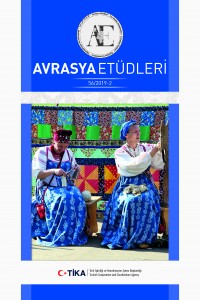Öz
Once a group of people are labelled as outsiders and removed from a given territory forcefully, they become the subject of a deportation practice. Additionally, the experiences during and after the deportation constitute an important component of in-group collective consciousness of deportees. This study is a case study built on the conceptual framework, which is also known as analytical framework. The study first aims to determine the reasons of the deportation of the Ahiska Turks. Then the study intends to connect the traumatic experiences of the Ahiska Turks during and after the process of the deportation and their years in exile to the construction of their collective group identity. At this point, this study argues that although the ideological dichotomisation of the world constituted the essential component of the
Soviet identity, this binarised understanding of the world flamed the fear of foreign penetration into the socialist community and triggered the Soviet xenophobia at home. Last but not least, although it is acknowledged that the identity construction is an ongoing process and the Ahiska Turks were subject of discrimination
and violence after 1968, this study limits itself by focusing on the experiences of the Ahiska Turks from 1944 to 1968 since 1944 was the year of their deportation was executed and 1968 was the year when their deportation was officially recognised and they were rehabilitated by the Soviet government.
Anahtar Kelimeler
Kaynakça
- Anderson, Bridget, Gibney, Matthew J., and Emanuela Paoletti. The Social, Political And Historical Contours Of Deportation, Oxford: Springer, 2013. Aydıngün, Ayşegül Baydar. “A Deported Nationality: The Ahiska Turks”, Journal Of International Affairs, Vol. 3, No. 4, 1999 (1998). Aydıngün, Ayşegül Baydar. “Creating, Recreating And Redefining Ethnic Identity: Ahiska/ Meskhetian Turks in Soviet and Post-Soviet Contexts”, Central Asian Survey, Vol. 21, No.2, 2002a, pp. 185-197. Aydıngün, Ayşegül Baydar. “Ahiska (Meskhetian) Turks: Source of Conflict in the Caucasus?”, The International Journal of Human Rights, Vol. 6, No. 2, 2002b, pp. 49-64. Aydıngün, Ayşegül Baydar, Harding, Çiğdem Balım, Hoover, Matthew, Kuznetsov, Igor and Swerdlow, Steve. “Meskhetian Turks: An introduction to Their History, Culture And Resettlement Experiences”, Cultural Orientation Resource Center - Culture Profile, Washington, DC, 2006. Beridze, Marine and Manana Kobaidze. “An Attempt to Create an Ethnic Group: Identity Change Dynamics of Muslimized Meskhetians”, ed. Karina Vamling, Language, History And Cultural Identities In The Caucasus, 2005, pp. 53-67.
Öz
Kaynakça
- Anderson, Bridget, Gibney, Matthew J., and Emanuela Paoletti. The Social, Political And Historical Contours Of Deportation, Oxford: Springer, 2013. Aydıngün, Ayşegül Baydar. “A Deported Nationality: The Ahiska Turks”, Journal Of International Affairs, Vol. 3, No. 4, 1999 (1998). Aydıngün, Ayşegül Baydar. “Creating, Recreating And Redefining Ethnic Identity: Ahiska/ Meskhetian Turks in Soviet and Post-Soviet Contexts”, Central Asian Survey, Vol. 21, No.2, 2002a, pp. 185-197. Aydıngün, Ayşegül Baydar. “Ahiska (Meskhetian) Turks: Source of Conflict in the Caucasus?”, The International Journal of Human Rights, Vol. 6, No. 2, 2002b, pp. 49-64. Aydıngün, Ayşegül Baydar, Harding, Çiğdem Balım, Hoover, Matthew, Kuznetsov, Igor and Swerdlow, Steve. “Meskhetian Turks: An introduction to Their History, Culture And Resettlement Experiences”, Cultural Orientation Resource Center - Culture Profile, Washington, DC, 2006. Beridze, Marine and Manana Kobaidze. “An Attempt to Create an Ethnic Group: Identity Change Dynamics of Muslimized Meskhetians”, ed. Karina Vamling, Language, History And Cultural Identities In The Caucasus, 2005, pp. 53-67.
Ayrıntılar
| Birincil Dil | İngilizce |
|---|---|
| Konular | Uluslararası İlişkiler |
| Bölüm | Araştırma Makalesi |
| Yazarlar | |
| Yayımlanma Tarihi | 9 Aralık 2019 |
| Yayımlandığı Sayı | Yıl 2019 Cilt: 56 Sayı: 2 |

